Sławomir Stańczak
RIS-assisted Physical Layer Security
Jan 30, 2025



Abstract:We propose a reconfigurable intelligent surface (RIS)-assisted wiretap channel, where the RIS is strategically deployed to provide a spatial separation to the transmitter, and orthogonal combiners are employed at the legitimate receiver to extract the data streams from the direct and RIS-assisted links. Then we derive the achievable secrecy rate under semantic security for the RIS-assisted channel and design an algorithm for the secrecy rate optimization problem. The simulation results show the effects of total transmit power, the location and number of eavesdroppers on the security performance.
Two-timescale weighted sum-rate maximization for large cellular and cell-free massive MIMO
Jul 08, 2024Abstract:We reconsider the problem of joint power control and beamforming design to maximize the weighted sum rate in large and potentially cell-free massive MIMO networks. In contrast to the available short-term methods, where an iterative algorithm is run for every instantaneous channel realization, we derive an iterative algorithm that can be run only sporadically leveraging known channel statistics, with minor performance loss. In addition, our algorithm also applies to the design of non-trivial cooperative beamforming schemes subject to limited sharing of instantaneous channel state information. Furthermore, our algorithm generalizes and outperforms the competing long-term methods from the massive MIMO literature, which are restricted to long-term power control only or to long-term joint power control and large-scale fading decoding design.
Unlocking the Potential of Local CSI in Cell-Free Networks with Channel Aging and Fronthaul Delays
Apr 19, 2024Abstract:It is generally believed that downlink cell-free networks perform best under centralized implementations where the local channel state information (CSI) acquired by the access-points (AP) is forwarded to one or more central processing units (CPU) for the computation of the joint precoders based on global CSI. However, mostly due to limited fronthaul capabilities, this procedure incurs some delay that may lead to partially outdated precoding decisions and hence performance degradation. In some scenarios, this may even lead to worse performance than distributed implementations where the precoders are locally computed by the APs based on partial yet timely local CSI. To address this issue, this study considers the problem of robust precoding design merging the benefits of timely local CSI and delayed global CSI. As main result, we provide a novel distributed precoding design based on the recently proposed team minimum mean-square error method. As a byproduct, we also obtain novel insights related to the AP-CPU functional split problem. Our main conclusion, corroborated by simulations, is that the opportunity of performing some local precoding computations at the APs should not be neglected, even in centralized implementations.
Optimized Detection with Analog Beamforming for Monostatic Integrated Sensing and Communication
Apr 15, 2024Abstract:In this paper, we formalize an optimization framework for analog beamforming in the context of monostatic integrated sensing and communication (ISAC), where we also address the problem of self-interference in the analog domain. As a result, we derive semidefinite programs to approach detection-optimal transmit and receive beamformers, and we devise a superiorized iterative projection algorithm to approximate them. Our simulations show that this approach outperforms the detection performance of well-known design techniques for ISAC beamforming, while it achieves satisfactory self-interference suppression.
Towards Bridging the Gap between Near and Far-Field Characterizations of the Wireless Channel
Mar 10, 2024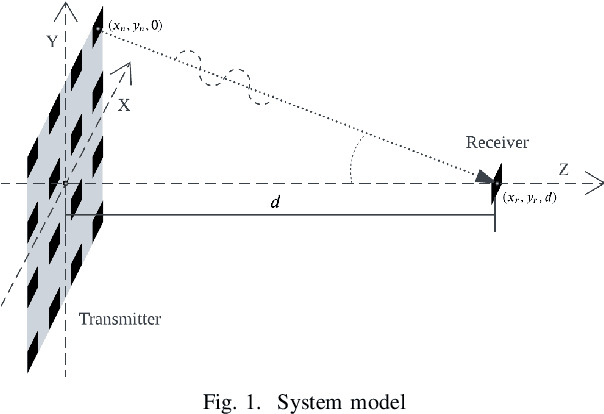

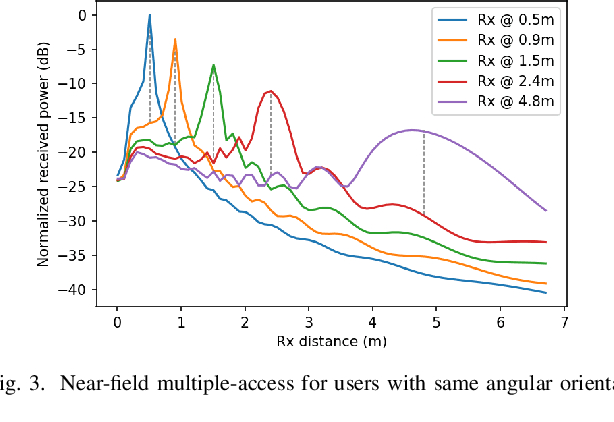
Abstract:The "near-field" propagation modeling of wireless channels is necessary to support sixth-generation (6G) technologies, such as intelligent reflecting surface (IRS), that are enabled by large aperture antennas and higher frequency carriers. As the conventional far-field model proves inadequate in this context, there is a pressing need to explore and bridge the gap between near and far-field propagation models. Although far-field models are simple and provide computationally efficient solutions for many practical applications, near-field models provide the most accurate representation of wireless channels. This paper builds upon the foundations of electromagnetic wave propagation theory to derive near and far-field models as approximations of the Green's function (Maxwell's equations). We characterize the near and far-field models both theoretically and with the help of simulations in a line-of-sight (LOS)-only scenario. In particular, for two key applications in multiantenna systems, namely, beamforming and multiple-access, we showcase the advantages of using the near-field model over the far-field, and present a novel scheduling scheme for multiple-access in the near-field regime. Our findings offer insights into the challenge of incorporating near-field models in practical wireless systems, fostering enhanced performance in future communication technologies.
QoS prediction in radio vehicular environments via prior user information
Feb 27, 2024Abstract:Reliable wireless communications play an important role in the automotive industry as it helps to enhance current use cases and enable new ones such as connected autonomous driving, platooning, cooperative maneuvering, teleoperated driving, and smart navigation. These and other use cases often rely on specific quality of service (QoS) levels for communication. Recently, the area of predictive quality of service (QoS) has received a great deal of attention as a key enabler to forecast communication quality well enough in advance. However, predicting QoS in a reliable manner is a notoriously difficult task. In this paper, we evaluate ML tree-ensemble methods to predict QoS in the range of minutes with data collected from a cellular test network. We discuss radio environment characteristics and we showcase how these can be used to improve ML performance and further support the uptake of ML in commercial networks. Specifically, we use the correlations of the measurements coming from the radio environment by including information of prior vehicles to enhance the prediction of the target vehicles. Moreover, we are extending prior art by showing how longer prediction horizons can be supported.
Fixed-point methods for long-term power control and beamforming design in large-scale MIMO
Dec 07, 2023Abstract:This study presents novel applications of fixed-point methods to solve previously open joint power control and beamforming design problems in modern large-scale MIMO systems, e.g., based on the cell-free massive MIMO and XL-MIMO concepts. In particular, motivated by the need for scalable system architectures, we revisit the classical sum power minimization and max-min fair design criteria by considering long-term power control and beamforming design based on channel statistics and possibly limited channel state information (CSI) sharing across distributed processing units. This approach is believed to mitigate the severe scalability issues of competing short-term optimal algorithms in the literature, which must be executed for every channel realization by a central controller endowed with global CSI, hence imposing very demanding requirements in terms of computation and interconnection capabilities. The obtained optimal algorithms are then illustrated and compared against existing short-term and long-term approaches via numerical simulations in a cell-free massive MIMO setup.
From Empirical Measurements to Augmented Data Rates: A Machine Learning Approach for MCS Adaptation in Sidelink Communication
Sep 29, 2023Abstract:Due to the lack of a feedback channel in the C-V2X sidelink, finding a suitable modulation and coding scheme (MCS) is a difficult task. However, recent use cases for vehicle-to-everything (V2X) communication with higher demands on data rate necessitate choosing the MCS adaptively. In this paper, we propose a machine learning approach to predict suitable MCS levels. Additionally, we propose the use of quantile prediction and evaluate it in combination with different algorithms for the task of predicting the MCS level with the highest achievable data rate. Thereby, we show significant improvements over conventional methods of choosing the MCS level. Using a machine learning approach, however, requires larger real-world data sets than are currently publicly available for research. For this reason, this paper presents a data set that was acquired in extensive drive tests, and that we make publicly available.
Robust cell-free mmWave/sub-THz access using minimal coordination and coarse synchronization
Aug 04, 2023Abstract:This study investigates simpler alternatives to coherent joint transmission for supporting robust connectivity against signal blockage in mmWave/sub-THz access networks. By taking an information-theoretic viewpoint, we demonstrate analytically that with a careful design, full macrodiversity gains and significant SNR gains can be achieved through canonical receivers and minimal coordination and synchronization requirements at the infrastructure side. Our proposed scheme extends non-coherent joint transmission by employing a special form of diversity to counteract artificially induced deep fades that would otherwise make this technique often compare unfavorably against standard transmitter selection schemes. Additionally, the inclusion of an Alamouti-like space-time coding layer is shown to recover a significant fraction of the optimal performance. Our conclusions are based on an insightful multi-point intermittent block fading channel model that enables rigorous ergodic and outage rate analysis, while also considering timing offsets due to imperfect delay compensation. Although simplified, our approach captures the essential features of modern mmWave/sub-THz communications, thereby providing practical design guidelines for realistic systems.
UL-DL duality for cell-free massive MIMO with per-AP power and information constraints
Jan 16, 2023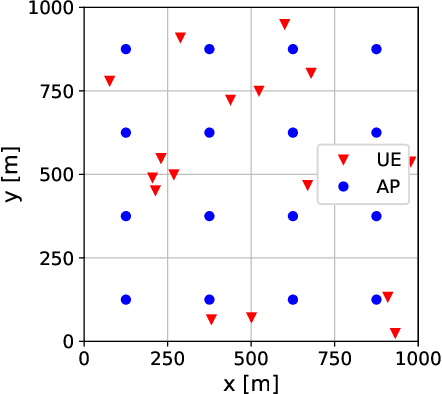
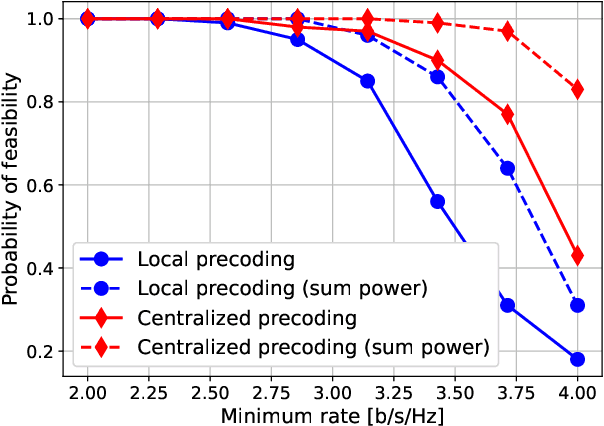
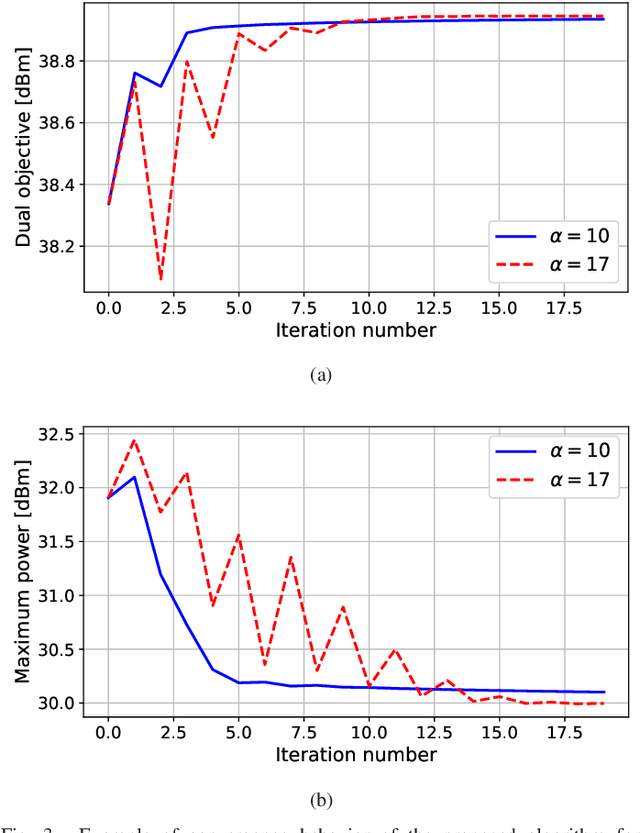
Abstract:We derive a novel uplink-downlink duality principle for optimal joint precoding design under per-transmitter power and information constraints in fading channels. The main application is to cell-free networks, where each access point (AP) must typically satisfy an individual power constraint and form its transmit signal on the basis of possibly partial sharing of data bearing signals and channel state information. Our duality principle applies to ergodic achievable rates given by the popular hardening bound, and it can be interpreted as a nontrivial generalization of a previous result by Yu and Lan for deterministic channels. This generalization allows us to cover more involved information constraints, and to show that optimal joint precoders can be obtained using a variation of the recently developed team minimum mean-square error method. As particular examples, we solve the problems of optimal centralized and local precoding design in user-centric cell-free massive MIMO networks subject to per-AP power constraints.
 Add to Chrome
Add to Chrome Add to Firefox
Add to Firefox Add to Edge
Add to Edge